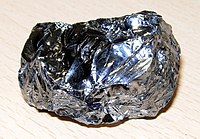
Photo from wikipedia
Abstract Rechargeable aluminum batteries are believed as a promising next-generation energy-storage system due to abundant low-cost Al sources and high volumetric specific capacity. The Al-storage cathodes, however, are plagued by… Click to show full abstract
Abstract Rechargeable aluminum batteries are believed as a promising next-generation energy-storage system due to abundant low-cost Al sources and high volumetric specific capacity. The Al-storage cathodes, however, are plagued by strong electrostatic interaction between host materials and carrier ions, leading to large overpotential and undesired cycling stability as well as sluggish ion diffusion kinetics. Herein, sulfur-linked carbonyl polymer based on perylene-3,4,9,10-tetracarboxylic dianhydride (PTCDA) as the cathode materials for ABs is proposed, which demonstrates a small voltage polarization (135 mV), a reversible capacity of 110 mAh g−1 at 100 mA g−1 even after 1200 cycles, and rapid Al-storage kinetics. Compared with PTCDA, the sulfide polymer possesses higher working voltage because of its lower LUMO energy level according to theoretical calculation. The ordered carbonyl active sites in sulfide polymer contribute to the maximized material utilization and rapid ion coordination and dissociation, resulting in superior rate capability. Besides, the bridged thioether bonds endow the polysulfide with robust and flexible structure, which inhibits the dissolution of active materials and improves cycling stability. This work implies the importance of ordered arrangement of redox active moieties for organic electrode, which provides the theoretical direction for the structural design of organic materials applied in multivalent-ion batteries.
Journal Title: Journal of Energy Chemistry
Year Published: 2021
Link to full text (if available)
Share on Social Media: Sign Up to like & get
recommendations!